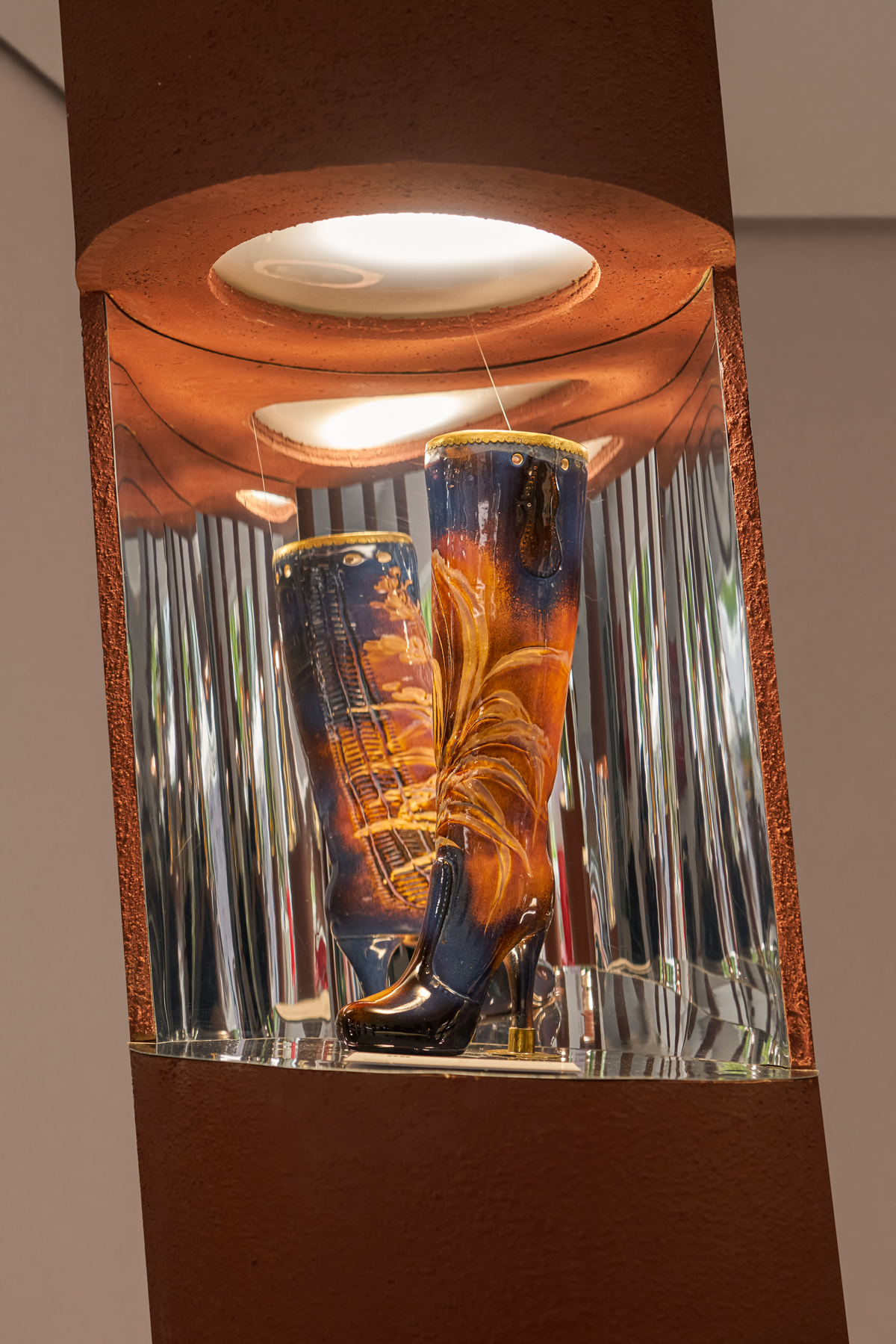Molding clay into boots is difficult but firing at 1200 degrees Celsius and keeping the shape intact is even more difficult. Despite having half a century of experience, he still had to try dozens of times, and it took six months of feats to find the solution. Overcoming the technical hurdles, he experimented with colors, tricks, and patterns. The creative inspiration did not end there. He continued to mix many new enamel colors and applied more complex and sophisticated techniques to the products.
Article by Phạm Quỳnh Châu
Photograph by Đỗ Sỹ

Presented at Đẹp Fashion Show in 2011, his works surprised the audience by the miraculously enchanting beauty of ceramic boots – an unexpectedly rustic material.
The boots are handcrafted one piece at a time, therefore every single boot is one – of – a kind. 47.5 cm high, 17 cm wide, 2.5 kg weight, the heel and toe box of the boot are copper-coated to create stability.
“The boot itself is already a beautiful shape with elegant curves, so it just needs some additional patterns to become a perfect work”, he said.
The traditional ceramic techniques, such as embossed patterns, debossed textures, and enamel color schemes, are common ones.. The same clay, the same kaolinite, the same mixing and color overlay techniques; however, to get to such a fanciful level requires decades of mastery experience. Many natural materials such as dried lotus, silk, and silver yarn are combined to create the unique features for each work. Material diversity, exotic combination, virtuoso techniques, the twelve masterpieces in the end still embrace a pure and passionate soul of Vietnamese pottery.. With such diversity, nevertheless, those twelve shades still embrace a pure and passionate soul of Vietnamese pottery.
For those reasons, Vu Thang’s twelve boots can be seen as the meeting of tradition and modernity, marking the beginning of the relationship between ceramics and fashion.

Brown-Glazed Ceramic Boot with Floral Motifs
Brown-glazed ceramic boots using a dry glaze to create an imitation bronze surface. Engraved lotus and chrysanthemum floral motifs recall the brown-glazed ceramics of the Lý–Trần dynasties (11th–14th centuries). Wooden beads and silkworm cocoons are incorporated as subtle decorative accents, adding a tactile contrast to the piece.

Turquoise-Glazed Ceramic Boot with Floral Motifs
A turquoise-glazed ceramic boot featuring engraved lotus and chrysanthemum floral motifs characteristic of Vietnamese ceramics. Multiple layers of glaze are applied to create a sense of spatial depth across the surface. Dried lotus calyx, wooden beads, and lacquered silkworm cocoons are added to the body and toe as rustic decorative accents.

Ivory-Glazed Ceramic Boot with “Hundred Flowers” Motifs
Finished in Bát Tràng’s signature ivory glaze, the boot is hand-painted in an ancient indigo tone with the “hundred flowers” motif—an interpretation inspired by the phrase nhân sinh bách nghệ. The composition evokes the vibrant diversity of Vietnam’s traditional crafts through its lively array of blossoms.

Turquoise-Glazed Ceramic Boot with Floral Motifs
Blending engraved lotus and chrysanthemum floral motifs with the layered-glaze technique, this turquoise-glazed ceramic boot reveals natural, unpredictable interactions between carved lines and shifting glaze tones. A subtle gradient from the collar to the toe enhances the sense of visual depth, making each piece truly one of a kind.

Turquoise-Glazed Ceramic Boot with Silver Detailing
Combining engraved floral motifs with the signature layered-glaze technique, this turquoise-glazed ceramic boot is distinguished by a silver-detailed collar. Fine silver threads are drawn, shaped into floral forms, and set onto the ceramic surface, creating a luminous contrast against the glaze.

Layered-Glaze Ceramic Boot with Orchid Motifs
A brown, layered-glaze ceramic boot featuring engraved orchid motifs—symbols of spring and a free-spirited grace. The orchids are carved with elegant lines and highlighted by a brown-to-deep-blue gradient created through the artisan’s distinctive multi-layer glazing technique.

Ivory-Glazed Ceramic Boot with Carp Motifs
An ivory-glazed ceramic boot painted in an ancient indigo tone on a light-toned ceramic body. The carp head at the toe and the meticulously rendered fish scales along the form reference the legend of “Carp Leaping Over the Dragon’s Gate,” a classic motif adapted into a contemporary object.

Ivory-Glazed Ceramic Boot with “Thuỷ Tam Waves” Motif
Painted in an ancient indigo tone on an ivory-glazed surface, the “thuỷ tam waves” motif symbolizes continuity, prosperity, and the interwoven flow of generations. Drawing from the aesthetics of East Asian blue-and-white ceramics, the composition forms a refined dialogue between traditional craftsmanship and a contemporary boot silhouette.

Layered-Glaze Ceramic Boot with Lime Blossom Motifs
The layered-glaze technique is used with restraint, creating a subtle backdrop for the engraved lime blossom motifs arranged in a seamless mesh pattern along the form. The composition carries a gentle echo of classic Western leather boot aesthetics.

Ivory-Glazed Ceramic Boot with “Dragon Drawing Water” Motif
Painted in an ancient indigo tone on a light-toned ceramic body, this ivory-glazed ceramic boot features the “dragon drawing water” motif—derived from 14th-century Trần Dynasty dragon imagery—rendered in elegant, expressive lines. As a companion to the carp-themed boot, it completes the narrative arc of the carp leaping the Dragon’s Gate and transforming into a dragon.

Layered-Glaze Ceramic Boots with “Long Hí Thủy” Motifs
Refined through engraved detailing and layered-glaze techniques, these ceramic boots reveal a surface with natural variations. The “long hí thủy” motif—rooted in Nguyễn Dynasty dragon imagery—captures the sinuous, majestic movement of the dragon, symbolizing a spirit that continually returns to its origins.

Layered-Glaze Ceramic Boots with Peach Blossom Motifs
Crafted through a combination of engraved detailing and layered-glaze techniques, these ceramic boots unfold as a multicolored composition highlighted by vibrant peach blossom motifs. Recognized by the Vietnam Guinness Record Organization in 2013, this pair is noted as the largest ceramic boots in the country.